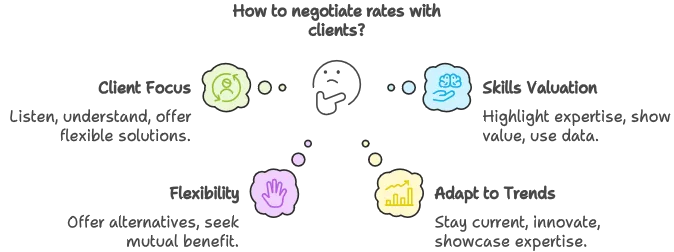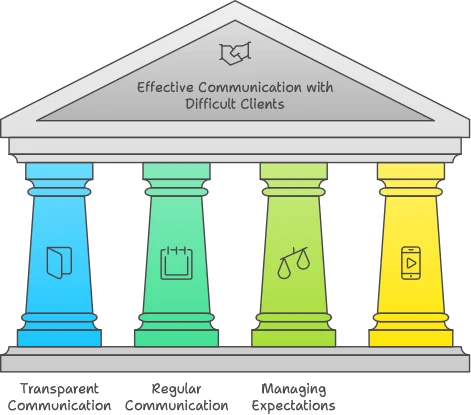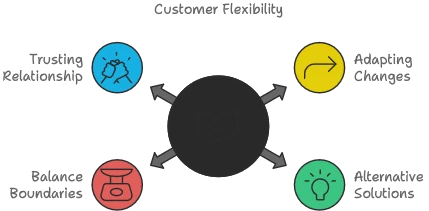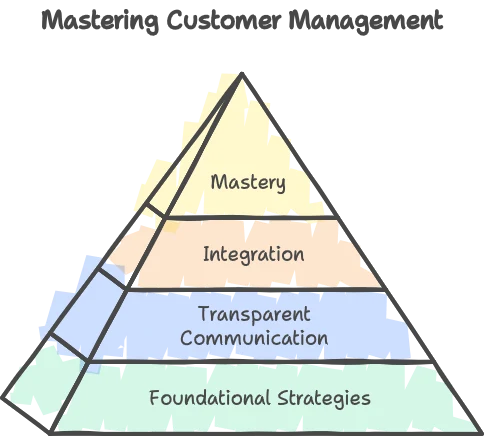1. Introduction to Managing Difficult Customers in Design
In the field of design, managing difficult customers is a crucial skill for maintaining positive relationships and successfully delivering quality projects. Designers encounter clients with varied expectations, changing preferences, and sometimes conflicting demands. Successfully navigating these situations requires a combination of communication, negotiation, and problem-solving skills. In this article, we will explore proven strategies for managing difficult customers in design, focusing on how to address indecisive and demanding clients, negotiate fees, and integrate Design Thinking into this process.
Addressing Indecisive Customers: Identifying Hidden Needs
When dealing with indecisive customers, it’s essential to delve beyond what is initially expressed. Use open-ended questions to encourage the client to explain their needs and concerns in detail. A deep understanding of their hidden expectations will help tailor more suitable solutions. Creating visual options, such as mockups or prototypes, can also be highly beneficial, allowing the client to visualize the final product and make more informed decisions.
Negotiating Fees: Showcasing Your Services and Justifying Costs
Negotiating fees can be delicate, but it’s crucial to highlight the value your services bring to the project and justify the costs. Emphasize how your expertise can solve the client’s problems and improve final outcomes. Also, highlight tangible benefits, such as efficiency gains or long-term returns on investment, that your work can offer.
Integrating Design Thinking into Managing Difficult Customers
An innovative approach to managing difficult customers is integrating Design Thinking into the process. Design Thinking is a user-centered methodology that encourages collaboration, creativity, and iteration. By using this approach, you can actively involve the client in problem-solving. Understanding the needs of the end-user, creating prototypes, and testing solutions can lead to more informed decisions and improved customer satisfaction.
Delivering a Clear and Precise Roadmap
A clear and precise roadmap is essential for managing client expectations and ensuring transparency. Define key project milestones in an understandable manner and use visualizations to illustrate the project’s progression. This will help the client gain an overall view of the process and feel engaged at every step. Regular communication on project progress and milestone achievements will strengthen client trust.

In summary, managing difficult customers in design requires a blend of communication, negotiation, and creativity. By identifying hidden needs, justifying costs, integrating Design Thinking, and maintaining transparent communication, you can turn challenges into opportunities. In the upcoming sections, we will delve deeper into specific strategies for managing difficult customers and optimizing your design process. Stay tuned to learn more about this essential skill for designers.
2. Responding to Indecisive Customers: Identifying Hidden Needs
When it comes to managing difficult customers in design, one of the most valuable skills designers can acquire is the ability to respond to indecisive customers. Indecisive clients can pose challenges, but they also offer a valuable opportunity to demonstrate the value of your expertise and build stronger relationships.
Using Open-Ended Questions to Clarify Expectations
Indecisive clients often struggle to clearly express their expectations. This may result from a lack of understanding of their own needs or difficulty in communicating their ideas. As a designer, it’s essential to ask open-ended questions to help the client clarify their expectations.
Open-ended questions are designed to encourage a detailed response rather than a simple “yes” or “no.” For example, instead of asking “Do you want the design to be modern?”, you could ask “Can you describe the visual style you envision for this project?” Open-ended questions prompt the client to think more deeply about their needs and provide more specific information.
Open-ended questions can also be used to delve deeper into the client’s motivations. For example, asking “Why is it important for you to have a modern design?” can help reveal the client’s underlying values and objectives. This deep understanding can inform your design decisions and contribute to meeting the client’s real needs.
Creating Visual Options to Facilitate Client Decision-Making
Indecisive clients can feel overwhelmed by the decision-making process, leading to delays and frustrations. To facilitate this process, designers can create multiple visual options to meet the client’s needs. By offering different approaches, you provide the client with the opportunity to see concretely what works best for them.
When presenting options, ensure they are explained clearly. Highlight the pros and cons of each choice and explain how each one addresses the client’s specific needs. This enables the client to make a more informed decision and feel involved in the process.
By implementing these strategies, designers can not only respond to indecisive clients but also turn their indecision into an opportunity for creative exploration. Different options can spark fruitful discussions and inspire new and innovative ideas.
Harnessing the Power of Iteration
Iteration is a common practice in design that can be particularly useful when responding to indecisive clients. Instead of striving immediately for the perfect solution, propose iterative versions of the design. This allows the client to see the evolution of the design and contribute at each stage of the project.
Iteration also provides the opportunity to explore different directions without investing too much time in a single option, thus allowing exploration of equally interesting alternative approaches. If one approach does not meet the client’s expectations, it’s easier to pivot to another iteration. This flexible approach reduces the risk of client frustration and demonstrates your commitment to finding the best solution for their needs.
What Are Our Tips for Managing Difficult Customers?
Responding to indecisive clients is a crucial skill in managing difficult customers in design. By asking open-ended questions and creating visual options, designers can help clients clarify their expectations and make informed decisions. This approach promotes smoother communication, enhances client confidence in your expertise, and leads to much more impactful results.
As a Product Owner or Project Manager, assisting your clients in clarifying their expectations and making informed decisions will place the client at the center of your project and aim to achieve results that meet your clients’ needs. This process will highlight your professionalism in the world of Design Thinking.

These approaches will facilitate fee negotiations to achieve success in your projects both technically and financially. Each stakeholder should be a winner in such design projects.
3. Fee Negotiations: Valuing Your Products & Services, Justifying Your Costs
In the context of managing difficult customers in design, fee negotiations are crucial. Clients can be demanding not only regarding the final outcome but also regarding the cost of your services. It’s essential to strike a balance to showcase your skills while justifying the associated costs.
To explore this aspect, the following section presents a table with key strategies for success in fee negotiations and maintaining a positive relationship with your clients.
| Theme | Domain Key Strategies for Negotiating Your Rates |
|---|---|
| 1. Client Focus | • Listen carefully and understand your clients’ needs, taking into account their financial concerns. • Offer flexible and personalized solutions that meet their expectations while respecting their budget. • Maintain transparent communication and adapt your proposals based on their feedback to ensure satisfaction. |
| 2. Skills Valuation | • Highlight the added value of design skills to enhance user experience and business outcomes. • Identify unique aspects of your skills to differentiate yourself from other designers. • Explain potential benefits and return on investment associated with your design services. • Use tangible data and case studies to illustrate the positive impact of your contribution. • Emphasize the consideration of principles such as usability and user experience in your designs. |
| 3. Flexibility in Negotiations | • Use flexibility as a negotiation tool by offering alternative solutions that meet the client’s needs. • Propose options such as installment payment plans, complementary services, or project scope adjustments. • Seek mutually beneficial solutions to build trust and demonstrate commitment to project success. |
| 4. Adaptation to New Trends and Technologies | • Integrate new technologies and trends to stay current in the design field. • Showcase your skills tailored to specific project and client needs. • Demonstrate your ability to innovate and bring creative ideas to projects. • Encourage team members to propose great solutions. |
In summary, adopting a customer-centric approach is crucial in design pricing negotiations. By actively listening to their expectations and proposing tailored solutions, you lay a strong foundation for positive and fruitful relationships. Transparent communication throughout reinforces mutual trust and underscores your commitment to customer satisfaction.

It’s essential to showcase the value of your design skills to justify your costs. Highlighting the added value of your services and explaining their concrete benefits creates a compelling justification for your rates. Additionally, flexibility in negotiations, staying abreast of new trends and technologies, and emphasizing your expertise further solidify your position and enhance your bottom line.
4. Integration of Design Thinking in Managing Difficult Customers
Design Thinking is a powerful new approach to managing difficult customers. Meeting complex challenges requires demanding collaboration. Design Thinking is more than just a problem-solving methodology; it’s a philosophy that puts the end-user at the center of the creative process.
This section explores how design thinking can be used as an effective tool to manage difficult customers and achieve positive results.
Understanding the Benefits of Design Thinking in Problem Solving
Design Thinking stands out for its ability to address problems holistically and empathetically. It encourages designers to empathize with users, understand their needs, and create solutions that directly meet those needs. When managing difficult customers, this user-centered approach can be extremely beneficial.
By adopting Design Thinking, you are better prepared to understand your customers’ underlying motivations, even if they are indecisive or demanding. You can dig deeper beyond superficial requests and identify hidden needs that guide their expectations. This deep understanding allows you to create solutions that have a real impact and truly address your customers’ concerns.
Applying the User-Centered Innovation Process for Effective Solutions
The Design Thinking innovation process follows a clear series of steps, from problem definition to prototype creation and testing. When managing difficult customers, you can integrate this process to develop customized solutions that address their specific needs. Here’s how to apply the user-centered innovation process in managing difficult customers:
• Empathy: Dive into the perspective of your difficult customers. Use interviews and observations to understand their concerns, motivations, and challenges. This step helps you build a deeper connection and demonstrate genuine understanding of their needs.
• Contextualization: Clearly identify the problems and challenges your customers face. This may extend beyond purely aesthetic aspects and touch on areas such as usability, efficiency, and overall experience. Define the problem comprehensively to encompass all relevant aspects.
• Ideation: Gather your team to generate innovative ideas in response to the identified problems. Encourage divergent thinking and consider out-of-the-box solutions. Involve your customers in this stage to co-create solutions that meet their specific needs.
• Prototyping: Create tangible prototypes that illustrate your ideas. These prototypes can be visual mockups, interactive wireframes, or even simulations. Prototypes allow you to visualize potential solutions and present them to your difficult customers for feedback.
• Testing: Subject your prototypes to testing with your difficult customers. Observe their reactions, gather feedback, and refine your prototypes accordingly. This step allows you to iterate rapidly and refine your solutions until they perfectly match your customers’ expectations.

Integrating Design Thinking in managing difficult customers can transform how you approach these collaborations. Instead of simply responding to requests, you create customized solutions that address your customers’ real needs. This user-centered approach builds trust, involves your customers more deeply, and creates results that have a real impact.
5. Providing a Clear and Precise Roadmap
A roadmap is a visual and structured representation of the key steps and objectives of a project. It allows for the chronological planning and visualization of phases and activities, promoting coordination and transparency. (see roadmap/timeline)
In the complex world of design, a clear and precise roadmap is akin to a navigational beacon that guides both designers and clients through the intricate journey of a project. For demanding or indecisive clients, a well-defined roadmap can serve as a unifying reference point, ensuring that expectations are aligned, milestones are met, and visions are translated into tangible results. In this section, we will explore the importance of providing a roadmap that leaves no room for ambiguity and highlights your commitment to managing even the most challenging clients.
Presenting a Roadmap in 3 Points

In the dynamic landscape of design, providing a clear and precise roadmap is a strategic move that lays the foundation for a successful collaboration, even with challenging clients. By clearly defining the project’s key steps, using visualizations to illustrate project progress, and facilitating informed decision-making, you create an environment of transparency, trust, and proactive engagement.
A well-structured roadmap acts as a bridge between your design expertise and your clients’ expectations. It ensures that both parties are on the same page, reducing misunderstandings and maximizing the potential for a smooth project journey.
When dealing with demanding or indecisive clients, a roadmap becomes a powerful tool for managing expectations and demonstrating your commitment to guiding them toward a successful design outcome.
6. Importance of Communication in Managing Difficult Customers
When it comes to managing difficult clients in the design field, communication plays a crucial role in maintaining a successful and harmonious collaboration. Transparent, regular, and effective communication can significantly contribute to easing tensions, avoiding misunderstandings, and building a trusting relationship with indecisive and demanding clients.
In this section, we will delve into the importance of communication in managing difficult clients in design, highlighting best practices and strategies for maintaining effective communication.
Transparent Communication: The Key to Trust
When dealing with difficult clients, transparency in communication is essential. Transparency involves being open about the challenges, constraints, and possibilities of the project. It also means sharing important information, even if it might be difficult to address. Clients appreciate candor and transparency because it assures them that you are committed to their success.
Use clear terms and avoid excessive technical jargon. Explain things in a simple and accessible manner, ensuring that the client fully understands every aspect of the project. Transparent communication eliminates misunderstandings and reduces the risk of dissatisfaction.
Maintaining Regular Communication
When dealing with difficult clients, it is crucial to maintain regular communication throughout the project. Establish a communication schedule and stick to it. Indecisive clients often need to feel informed and involved at every step. A lack of communication can lead to anxiety and doubt in the client.
Use different communication methods based on the client’s preferences. Some prefer face-to-face meetings, while others prefer updates via email or phone calls. Adapt to the client’s needs to ensure smooth and seamless communication.
Managing Client Expectations Through Effective Communication
Effective communication also helps manage client expectations proactively. Difficult clients often have high expectations and can be disappointed if these expectations are not met. Communication can help align the client’s expectations with the reality of the project.
During initial discussions with the client, be clear about what is achievable and the project’s limitations. If changes occur along the way, communicate them immediately to the client and explain the reasons for the change. Proactive communication about potential challenges and necessary adjustments helps maintain a trusting relationship with the client.
Communication: A Call to Action
Depending on the situation, calls to action play an important role in communication with difficult clients. When providing information or updates, encourage a specific action from the client.
Examples of calls to action include:
- Please provide your feedback on this proposal;
- Please return this document by the date…;
- Reply to this email to give your approval to move to the next stage;
- Respond via Trello using the URL link…
CTAs facilitate client interaction with the provided information and encourage active participation. This can also help speed up the decision-making process by asking the client to actively engage in the project.
Communication is the glue that maintains successful collaboration with difficult clients, particularly in creative projects. Transparent, regular, and effective communication builds trust, eases tensions, and aligns client expectations with the reality of the project.
Ask for feedback after a few days to encourage active interaction and consider the client’s preferred communication methods: Emails, Instant Messaging, Project Management Tools, etc. However, also promote the channel that allows you to manage your tasks and track your projects’ progress (e.g., Trello).
Developing your communication skills and following the best practices we share will enable you to turn the challenges of managing difficult clients into opportunities to strengthen client relationships and create exceptional results in the design field.

Remember that each client is unique, and by adapting your communication approach to each specific client, you will build lasting and fruitful relationships.
7. Managing Feedback Constructively to Improve Customer Satisfaction
One of the crucial skills for effectively managing difficult design clients is the ability to handle feedback constructively. Feedback, whether positive or negative, is a valuable resource for improving your skills, refining your projects, and enhancing client satisfaction. In this section, we will explore how to strategically approach feedback and incorporate it into your process for managing demanding clients.
Transforming Negative Feedback into Growth Opportunities
When working with difficult clients, receiving negative feedback is inevitable at some point. However, instead of viewing this feedback as criticism, see it as an opportunity for learning and growth. Negative feedback can provide valuable insights into areas that need improvement and adjustments.
Take the time to objectively examine negative feedback. Identify trends and recurring issues raised by clients. This will allow you to target specific areas that require your attention. By taking steps to address these issues, you show your commitment to delivering a quality experience for your clients.
Creating a Constructive Dialogue with the Client
When receiving feedback, it is important to maintain an open and constructive dialogue with the client. Avoid taking comments personally and focus instead on resolving the issues. Ask questions to better understand the client’s concerns and seek mutually beneficial solutions.
A constructive dialogue can strengthen the relationship with the client and show that you take their feedback seriously. If the client expresses concerns, take the time to explore the reasons behind the feedback and work together to find solutions. This proactive approach can turn a difficult situation into an improvement opportunity.
Using Feedback to Adjust Your Approach
Feedback not only serves to resolve current issues but also to enhance your overall approach to difficult clients. If you identify similar issues raised by multiple clients, this could indicate a weakness in your process or communication. Use this information to make adjustments that will prevent these problems from recurring in the future.
For example, if several clients have difficulty understanding the project timeline, consider providing visual tools or regular updates to clarify the process. By adjusting your approach based on feedback, you demonstrate your commitment to offering an improved client experience.
Creating a Culture of Open Feedback
To manage feedback effectively, create a culture of open feedback within your team and with your clients. Encourage your clients to share their honest feedback and ensure they feel comfortable doing so. Provide simple and practical means for collecting feedback, such as surveys or feedback sessions.
Within your team, also encourage colleagues to exchange constructive feedback. Different perspectives can offer innovative ideas for solving problems and improving projects. Creating an environment where feedback is valued promotes continuous learning and constant improvement.
Summary on Managing Client Feedback
Managing feedback is an essential skill for successfully dealing with difficult design clients. Transform negative feedback into opportunities for learning and growth, and ensure you maintain a constructive dialogue with your clients. Use feedback to adjust your approach and create a culture of open feedback within your team and with your clients.

By adopting a proactive approach to feedback, you demonstrate your commitment to delivering high-quality projects and continuously improving your performance. Feedback thus becomes a valuable resource for enhancing client satisfaction, refining your skills, and evolving as a design professional.
8. Flexibility as Key to Managing Difficult Customers
When it comes to managing difficult clients in design, flexibility is an essential quality that can help you successfully navigate challenges and obstacles. Being flexible in your approach and solutions can not only improve your relationship with the client but also ensure positive outcomes for all parties involved. In this section, we will present a table highlighting the importance of flexibility and how to apply it in managing demanding clients.
4 Key Strategies for Flexibility
| Theme/Area | Key Strategies |
|---|---|
| A. Adapting to Changes in Direction and New Requests | • Adapt to changing needs and new expectations of clients. • Discuss new requests openly with the client and assess their feasibility. • Integrate changes if possible without compromising project quality. • Show your willingness to work together to achieve the best results. |
| B. Offering Alternative Solutions to Meet Changing Needs | • Suggest creative solutions if the client’s requests are beyond reach. • Offer alternatives that meet the client’s needs while considering constraints. • Optimize the project to maintain its quality and value despite challenges. • Demonstrate your commitment to the project’s success in the face of changes. |
| C. Maintaining a Balance Between Flexibility and Boundaries | • Set clear boundaries to avoid excessive demands. • Communicate the implications of requested changes professionally. • Propose alternatives if requests compromise quality or resources. • Manage client expectations while preserving work quality. |
| D. Cultivating a Trusting Relationship | • Use flexibility to strengthen trust and the client relationship. • Work with the client to find solutions that meet their changing needs. • Create an environment where the client feels heard and understood. • Foster harmonious cooperation and opportunities for long-term collaboration. |
As a professional, self-employed individual, or freelancer, embrace openness and practice active listening. Managing difficult clients requires flexibility, which is key to adapting to changes in direction and proposing innovative and unexpected solutions.

Additionally, you need to maintain a balance between flexibility and boundaries to improve your client management process and ensure positive results.
Opting for a CRM is an IMPORTANT point to integrate into your business process. These tools, highly adaptable to complex and demanding client relationship situations, are must-haves.
And when it comes to processes, it involves operating modes, contracts, and administrative and legal management if the case arises. This is why we will address the importance of having a mutual agreement with your client or prospect, especially before committing resources such as expenses and other associated costs.
9. Establishing Clear Limits and Agreements to Prevent Conflicts
In managing difficult clients in design, establishing clear boundaries and well-defined agreements from the start of the project can play a crucial role in preventing conflicts and misunderstandings. By setting precise expectations and objectives, you create a transparent working framework that promotes harmonious and effective collaboration. In this section, we will explore the importance of establishing clear boundaries and agreements, along with tips for successfully implementing them.
Define Clear Expectations and Objectives from the Start
The first step in setting clear boundaries is to define clear expectations and objectives from the beginning of the project. This means discussing in detail with the client what they expect from the project, the features they want included, the timelines they envisage, and the available resources. Open and honest communication at this stage can prevent future misunderstandings.
Ask the client specific questions to clarify their expectations. For example, inquire about the main features they want in the design, how they envision user interaction with the final product, and their priorities in terms of deadlines. By clearly understanding the client’s expectations, you can better align your actions and efforts to meet their needs.
Develop Detailed Contracts and Agreements
To formalize boundaries and expectations, it is essential to develop detailed contracts and agreements. These legal documents clearly outline the project terms, including details on deliverables, timelines, costs, and the responsibilities of each party. A well-drafted contract can protect your interests and minimize the risk of conflicts.
Ensure that the contract covers all aspects of the project, including the elements discussed with the client. Specify the stages of the design process, included revisions, delivery timelines, and payment terms. If specific elements are unclear in the contract, they can lead to disagreements later. Therefore, it is best to include everything in detail.
Clarify Boundaries and Responsibilities
Beyond contracts, it is important to clarify boundaries and responsibilities as the project progresses. Explain to the client the services you offer and those not included in the project. For example, if the client requests excessive revisions or modifications outside the initial scope, inform them that this could incur additional costs.
Also, clarify how revisions will be handled and what the expectations are regarding response times. Establishing expectations concerning communication and availability can prevent frustrations and delays. When responsibilities and boundaries are clear, you reduce the risk of misunderstandings that could lead to conflicts.
Prevent Conflicts and Promote Collaboration
Establishing clear boundaries is not just about setting strict rules but also about creating a work environment conducive to collaboration. When expectations are mutually understood and accepted, both parties can work together more harmoniously. This can strengthen trust and promote open and honest communication.
If situations arise that require adjusting boundaries, approach them with professionalism and an open mind. Propose alternative solutions that meet the client’s needs while preserving the project’s integrity. By maintaining transparent communication and demonstrating flexibility when appropriate, you can prevent conflicts and maintain a positive relationship with the client.
How to Agree with Your Client?
Ensuring mutual agreement with your client involves:
- Clear Communication: Discuss all aspects of the project thoroughly.
- Detailed Documentation: Draft contracts that cover all agreed-upon terms.
- Setting Expectations: Clearly outline what is included and what is not.
- Professionalism: Handle changes and disputes with a professional attitude.
- Flexibility: Be willing to adjust when necessary while maintaining project integrity.

By following these steps, you create a solid foundation for a successful project and a positive working relationship with even the most demanding clients.
! We reiterate HERE !
This approach helps prevent conflicts and misunderstandings.
By defining expectations, drafting detailed contracts, and clarifying responsibilities, you create a transparent working framework that promotes collaboration and mutual trust.
This strategy contributes to smoother management of difficult clients and enhances your reputation as a professional Designer.
10. Mastering Difficult Customer Management with Proven Strategies
Managing difficult customers through Design Thinking is a constant challenge for industry professionals. However, by implementing proven strategies, using Design Thinking and taking a proactive approach, transforming complex situations into opportunities for learning and growth is paramount. In this final section, we’ll recap the key points covered in this comprehensive article and highlight the importance of mastering the management of difficult customers.
Summary of strategies covered
Over the course of this article, we’ve explored various strategies for effectively managing difficult customers in design. From identifying the hidden needs of undecided customers, to adding value to your services during price negotiations, to integrating Design Thinking into your management approach, we’ve covered each step in detail.
We also discussed the importance of transparent communication, constructive feedback management, flexibility and setting clear boundaries to prevent conflict. Each strategy contributes to creating a harmonious working environment and satisfying customers, while preserving the quality of your work and your professional reputation.
If you’d like to know more, NLP is a great concept to learn more about.
Integrate the new Strategies into your day-to-day work
Mastering the management of difficult customers is of crucial importance to design professionals. Not only does it enable you to maintain a positive relationship with your clients, it can also enhance your credibility and reputation within the industry.Difficult customers are often those who pose the greatest challenges, but also the greatest opportunities for improvement.
By developing the skills needed to respond to indecisive customers, negotiate successfully and integrate Design Thinking into your management process, you’re better prepared to handle a variety of situations.The ability to turn negative feedback into opportunities for improvement and maintain transparent communication can set you apart as a highly skilled and reliable professional..Integrating strategies into your approach
Integrate the Strategies you have studied into your daily work
Managing difficult customers in design is not just about applying strategies once confronted with a demanding customer. It’s an ongoing approach that needs to be integrated into your overall work process. By incorporating Design Thinking principles and adopting effective communication practices from the outset of a project, you can anticipate and mitigate potential challenges.

Conclusion
In short, you’ll need practice to master managing difficult customers through Design Thinking. Note that it’s important to take specific actions, to explore in depth all the options for a complete understanding of your difficult customer.
In the field of Design, continuous learning, exploration of Design Thinking, effective communication and negotiation, as well as openness to feedback, are necessary to successfully tackle the complexity of managing difficult customers.



